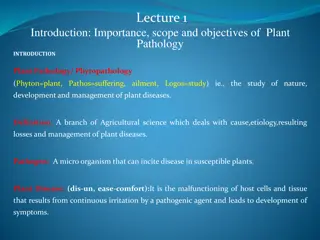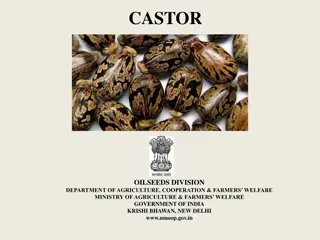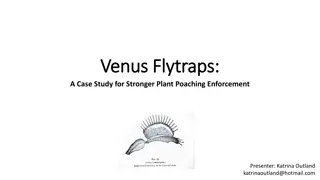Everything You Need to Know About Castor Plant and Its Uses
Castor (Ricinus communis L.) is an ancient non-edible oilseed with significant industrial and medical value due to its high oil content, unique fatty acid composition, and various applications. India dominates world production, with China and Brazil also being important producers. Castor plants have tall and short varieties, with distinct morphological characteristics. The oil derived from castor seeds is used in diverse industries such as textiles, cosmetics, pharmaceuticals, and paints, thanks to its high viscosity and stability. The plant's origin is believed to be in Ethiopia, and it belongs to the Euphorbiaceae family.
Download Presentation

Please find below an Image/Link to download the presentation.
The content on the website is provided AS IS for your information and personal use only. It may not be sold, licensed, or shared on other websites without obtaining consent from the author.If you encounter any issues during the download, it is possible that the publisher has removed the file from their server.
You are allowed to download the files provided on this website for personal or commercial use, subject to the condition that they are used lawfully. All files are the property of their respective owners.
The content on the website is provided AS IS for your information and personal use only. It may not be sold, licensed, or shared on other websites without obtaining consent from the author.
E N D
Presentation Transcript
CASTOR (Ricinus communis L.)
Castor is one of the ancient and important non edible oilseeds that has immense industrial and medical value. The genus Ricinus is derived from the latin term meaning dogtick because of the resemblance of the seed as that of common pest of dogs. The major composition of seed is the oil, constituting 50-55% which is unique in terms of dominance of a single fatty acid ricinolic acid to the tune of 90% due to which special properties of oil and its users are achieved.
Uses of Castor Castor oil contains ricinoleic acid (90%), which imparts high viscocity and oxidative stability. It its four times stable than olive oil, which is relatively more stable among edible group. The oil is used as high quality lubricant because of its ability to remain liquid at low temperature and viscous at high temperature. They are used in textiles, soaps, cosmetics, nylon etc. Castor oil is used in pharmaceuticals as a laxative and soothing agent. A large quantity of castor oil is used in paints and varnish industry. It is source of number of synthetic flower scents and fruit flavours. Castor cake has anti tumour properties Green leaves are used for raising eri silkworm.
Area, production and distribution India accounts for nearly 61% of world s castor area and 73% of world s castor production. China and Brazil are the important countries producing castor. Castor is also grown to a small extent in Thailand , Ethiopia, Philippines, Paraguay, Ecuador, Pakistan and Sudan. Highest world productivity is observed in Paraguay. Origin and Systematics Castor belongs to the genus Ricinus and to the family Euphorbiaceae. Ethiopia or East African region is considered to be the most probable site of origin.
Morphology and Biology Castor plants can be divided into two types , tall and short, commonly giant and dwarf castor. Giant types have a root system similar to typical woody perennials with a large, well developed tap root which can reach several metres in length and has substantial lateral and secondary roots. Dwarf types have root system which reflects the particular variety or cultural system and the tap root is less apparent. The well developed secondary root system is much branched and often deeply penetrating to take maximum advantage of soil moisture.
The stem is round, glabrous, frequently glaucous and covered with a waxy bloom which gives red or green stem bluish appearance in field. It is considered that varieties with a heavy waxy bloom are more resistant to jassids or leaf hoppers than bloom less types. The large leaves are usually dark glossy green, palmate with 5-11 lobes and prominent veins on the under surface. The inflorescence which forms a pyramidal raceme also known as the spike or candle. The lower portion of raceme bears male flowers, the upper female, the ratio between them being a varietal characteristic, but it is also strongly influenced by climate. High temperature favours maleness, as does plant age and short day length. Spraying with gibberllin tend to increase female proportion. Pollen is shed readily between 26 and 29 C with a relative humidity of 60%, but a temperature of 15 C delays shedding and lower temperature can injure grains. Castor is normally cross pollinated.
The fruit is a globular capsule, spiny to some degree, which becomes hard and brittle when ripe. The capsule contains 3 seeds, a flattered oval in shape. Germination is epigeal and seedlings normally emerge 10-12 days after sowing. Germinability of seeds drops drastically after 2 or 3 years, unless seeds are stored under cool and dry conditions.
Castor zones in India Castor is cultivated in several agro climatic regions Zone 1: North Gujarat and some parts of Rajastan Zone 2: Rainfed castor, Guntur of A.P, Mandya, Mysore, Tumkur Chitradurga of Karnataka Zone 3: River basins of Bhagalpur, Purnea and Munger districts of Bihar. Zone 4: Leafy and long duration perennial grown in backyards, wastelands ad marginlands for raising eri silkworm feeding in north- eastern India. Zone 5: On field bunds in coastal districts of A.P and Maharashtra primarily as wind breaks.
Crop adaptation Castor is hardy perennial plant well adapted to semi tropical environment and grown on wide range of climatic conditions throughout warm temperate and tropical regions. Castor has been commercially cultivated from 40 S to 52 N latitudes and from sea level to 2000 MSL. Optimum altitude is between 300 and 1,500 m MSL. Castor requires temperature ranging from 20-26 C with low humidity and long clear summer days throughout the growing period to produce a maximum yields. Cloudy or humid days throughout the growing period produce maximum yields. Cloudy or humid days irrespective of temperature will reduce the yields and castor is highly susceptible to frost. Humid and cloudy weather during flowering period will promote fungal disease of the inflorescence resulting in total loss of spike, a hard frost will kill the castor plant at any stage of growth, young plants being more susceptible and a frost free period of 140-190 days is necessary for successful castor production. The warm temperature at the time of flower initiation promotes more male female flowers within a given genotype.
Castor is along day plant and is adaptable with some loss of yield to fairly wide day length range. Castor is drought tolerant plant well adapted to low moisture conditions by way of deep rooting and having reflector bloom on stem and leaves to reduce heat load and thrive under conserved moisture. Higher yields of castor can be realized with moderate rainfall of 600-700 mm and fairly good yields have been obtained with well distributed rainfall of 375-500 mm. Adoption of efficient soil and moisture conservation practices can result in higher castor yields for the same amount of rainfall. It was established that the requirements of rainfall for castor during different periods of growth are not uniform. Excess rainfall in the first half of vegetation and during late autumn is harmful as it leads to quick vegetative growth harming the reproductive growth. Cyclonic showers in Andhra Pradesh in September-November when the kharif sown castor is flowering and capsule formation stages, completely devastates the crop due to the occurrence of botrytis disease.
Soil Heavy and poorly drained soils are not good. Castor is often selected for growing in marginal lands which are generally not suitable for other crops. Castor root system is unique has a central tap root with few laterals and root hairs are predominantly absent. In india castor is cultivated in shallow sandy loams with as little clay content as 10% locally known as chalka soils in A.P to deep sandy loams in Gujarat. In Orissa, Karnataka and Tamilnadu soils are relatively deep. Slight soil acidity of pH 5 to 6.5 is preferred by castor but it can tolerate alkalinity up to pH 8.0.
Tillage Disk ploughing after the preceding crop harvest followed by deep ploughing and final land preparation by 2-3 harrowings resulted in 24% yield advantage of castor in normal rainfall year, the effect was marginal in low rainfall years. Castor is a hardy crop for moisture stress and a better crop of castor acn be obtained by following insitu conservation of moisture. Summer tillage or off season tillage with premonsoon rain not only helps in removal of first flushes of weeds, better infiltration of rainwater but also facilitates in early seedbed preparation well in advance before the commencement of rains.
Sowing time Under dryland conditions, early sowing with the onset of monsoon is the best to have the advantage of rainfall from beginning. The practice of farmers in dryland areas of Andhra Pradesh is to delay the sowing of castor to July to avoid the problem of red hairy caterpillar. Under winter condition optimum time of sowing for castor is the period when the soil temperature in the seeding zone has warmed up to 10-12 C. On weed less fields sowing is done earlier to permit slow emerging castor under weed free competition.
Sowing depth Optimum seeding depth plays an important role in ensuring timely and uniform germination and emergence. The germination of castor is epigeal and relatively less sensitive to soil crust problems due to its good strength to break crust. However under light soil deep placement at 8-10 cm is safer under sufficient moisture conditions, placing seed at 6-8 cm ensures better seed germination and emergence. In heavier soils seeding depth should not be more than 5-6 cm.
Sowing Method Castor is generally sown by dropping seeds in furrows opened by plough at desired row spacing in drylands of A.P. It is dibbled at regular spacings and depth under irrigated conditions in Gujarat. Thus in A.P despite of higher seed requirement for the expected population in dryland the plant stand establishment will be poorer and there will be higher intra-row plant competition resulting in lower yields of castor, besides limiting intercultural operation.
Varieties Aruna is early flowering medium dwarf plant type. Other varieties were SA-2, V-19, RC-6. Further development of castor production was made with the development of hybrids beginning with GCH 3, GAUCH 1, GCH 2 and GCH 4. The first 3 hybrids were susceptible to wilt complex and GCH 4 offered higher degree of stability under normally sown condition coupled with resistance to wilt caused by Fusaria. Sowbhagya is dwarf stature suited for intercropping with sorghum. Variety 48-1 is of medium and superior to Aruna in yield under normal sowing. This variety is highly resistant to wilt.
Plant population and spacing Castor could be planted with a spacing of 90x30 cm to 150x75 cm, depending on the variety, its duration, and season, type of soil and avialabilty of irrigation. Due to branching castor has wide plasticity for adjustments in spacing and plant population by adjustments in branching and yield per plant to give a normal yield/ ha. The general optimum population is around 40000-60000 plants/ ha which requires 10- 15 kg of seeds. For irrigated condition, lower plant population of 18500 plants /ha is optimum with 5-6 kg /ha of seeds. The wide spacing reduces the incidence of botrytis under the situation of disease epidermis due to less favourable microclimate for the disease development.
Nutrient management Castor is highly responsive to fertilizers. It has been estimated that 1.7 tonnes /ha seed yield of castor removes the equivalent of 50 kg N, 20 kg P2O5 and 16 kg K apart from the nutrient removal through root stem and leaves. High fertilization to varieties with low yield potential results in excessive vegetative growth and delay in maturity. In general application of fertilizers to castor is low. Rainfed situation : 40:40:0 kg N: P2O5: K2O/ha Irrigated : 40:40:40 kg N: P2O5: K2O/ha Integrated nutrient management practices involving crop rotation with legumes, green manuring, phosphate solubilising bacteria etc. will legumes, green manuring; PSB will greatly reduce the cost on fertilizers besides improving soil fertility.
Water management Castor is highly drought tolerant crop but responds well to irrigation. The magnitude of response to irrigation is higher with hybrids than varieties. The root growth of castor under irrigated conditions will be restricted to surface layers whereas root grows deeper under rainfed situations. The ideal water management schedule for castor 1. Irrigation during the first half of vegetative period, particularly during the period of peak flowering is critical. 2. Retention of moisture in the active root zone by irrigation at 70% FC during vegetative and ripening periods and at 80% FC during flowering period. 3. High moisture conditions during the maturity period cause spurt of new leaves and vegetative shoots and delays maturity.
Weed management Castor requires weed free period for 45-50 days. Clean cultivation in terms of summer ploughing and thorough seed bed preparation eliminates the weeds to a large extent before sowing of crop. Use of pre emergent herbicide like pendimethalin at sowing in wet soil provides good control of weeds. Intercultivation by hoeing and hand weeding once at 30-35 DAS provides competition free environment for slow growing castor which later cover up land area and tolerate and suppress the weeds.
Pest management Major pests are Semilooper and red hairy caterpillar. Management include hand picking of larvae, using parasites and spraying of Monocrotophos. Trap can also be used. Diseases include wilt complex consisting of Fusarium, Macrophomina, Rhizoctonia and nematodes. Management 1. Avoid continuous castor cultivation 2. Avoid long duration varieties 3. Use of resistant genotypes like Jyothi, Jwala, GCH-5 4. Intercropping with pigeon pea 5. Reduce dose of nitrogen 6. Reduce frequent irrigation 7. Seed treatment with Bavistin
Harvesting and yield In Gujarat harvesting is done at green stage of the capsule and multiple harvests are made as per the order and maturity of spike resulting in higher yields. Harvesting by cutting the entire spike from the plant followed in Gujarat and after sun drying threshing is done to obtain seeds, while in A.P the dried capsules on the spike are plucked out, collected and threshed. On an average 0.8-1 tonne/ ha yield is obtained under rainfed and about 1.5 to 2 tonnes/ha under irrigated condition depending on genotype and growing condition.























